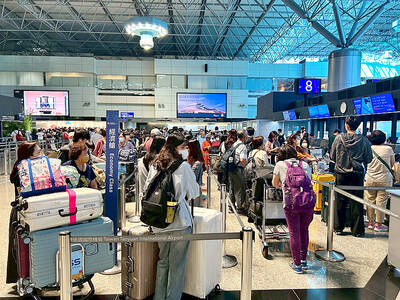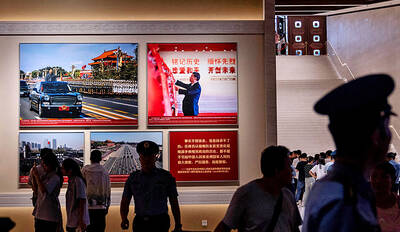Three people who had traveled to Myanmar tested positive for typhoid fever last month, the Centers for Disease Control (CDC) said.
Two students and one businessman who visited Myanmar in December last year, and in January, began to develop symptoms, including fever, headache, diarrhea and loss of appetite last month.
Laboratory tests confirmed that all three had typhoid fever, the CDC said.
All three were hospitalized, and two have since been discharged, it added.
The center has traced and examined the 73 people who have had contact with the three patients. None have developed typhoid-related symptoms.
That brings the total of typhoid cases this year to five; the other two patients had traveled to Indonesia.
There were 29 confirmed cases of imported typhoid fever, mainly from Indonesia, Myanmar, India and the Philippines, over the past three years: 11 in 2010, seven in 2011 and 11 last year.
Luo I-chun (羅一鈞), a physician specializing in disease prevention at the center, advised people traveling to Southeast Asia to pay attention to personal hygiene and food sanitation and to avoid uncooked food such as salads.
“Salads may be contaminated by unwashed hands or bacteria-carrying flies. Travelers are also advised to drink bottled water,” Luo said.
Luo also suggested getting vaccinated before traveling to these areas.
“There are 12 travel medical clinics where people can get vaccinated,” Luo said, adding that travelers have to be at least two years old to receive the vaccine.
“[The vaccine] costs about NT$1,380, not including treatment fees,” he said.
“However, the vaccine works for only two years and is only between 50 percent and 80 percent effective,” he added.

Three batches of banana sauce imported from the Philippines were intercepted at the border after they were found to contain the banned industrial dye Orange G, the Food and Drug Administration (FDA) said yesterday. From today through Sept. 2 next year, all seasoning sauces from the Philippines are to be subject to the FDA’s strictest border inspection, meaning 100 percent testing for illegal dyes before entry is allowed, it said in a statement. Orange G is an industrial coloring agent that is not permitted for food use in Taiwan or internationally, said Cheng Wei-chih (鄭維智), head of the FDA’s Northern Center for

The Chinese military has built landing bridge ships designed to expand its amphibious options for a potential assault on Taiwan, but their combat effectiveness is limited due to their high vulnerability, a defense expert said in an analysis published on Monday. Shen Ming-shih (沈明室), a research fellow at the Institute for National Defense and Security Research, said that the deployment of such vessels as part of the Chinese People’s Liberation Army (PLA) Navy’s East Sea Fleet signals a strong focus on Taiwan. However, the ships are highly vulnerable to precision strikes, which means they could be destroyed before they achieve their intended

About 4.2 million tourist arrivals were recorded in the first half of this year, a 10 percent increase from the same period last year, the Tourism Administration said yesterday. The growth continues to be consistent, with the fourth quarter of this year expected to be the peak in Taiwan, the agency said, adding that it plans to promote Taiwan overseas via partnerships and major events. From January to June, 9.14 million international departures were recorded from Taiwan, an 11 percent increase from the same period last year, with 3.3 million headed for Japan, 1.52 million for China and 832,962 to South Korea,

REWRITING HISTORY: China has been advocating a ‘correct’ interpretation of the victory over Japan that brings the CCP’s contributions to the forefront, an expert said An elderly Chinese war veteran’s shin still bears the mark of a bullet wound he sustained when fighting the Japanese as a teenager, a year before the end of World War II. Eighty years on, Li Jinshui’s scar remains as testimony to the bravery of Chinese troops in a conflict that killed millions of their people. However, the story behind China’s overthrow of the brutal Japanese occupation is deeply contested. Historians broadly agree that credit for victory lies primarily with the Chinese Nationalist Party (KMT)-led Republic of China (ROC) Army. Its leader, Chiang Kai-shek (蔣介石), fled to Taiwan in 1949 after losing a